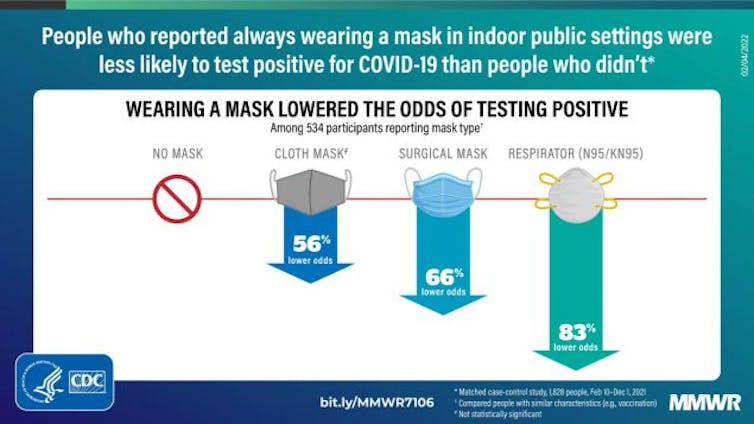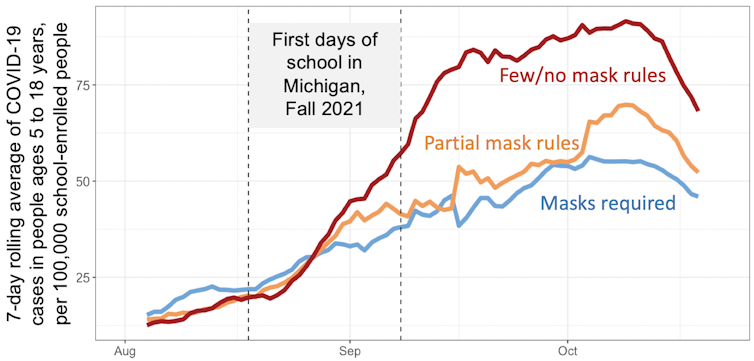The 2022 cold and flu season is off to a strong start. Viruses that have been unusually rare for the past three years are reappearing at remarkably high levels, causing a “tripledemia” of COVID-19, the flu, and respiratory syncytial virus, or RSV. National influenza hospitalization levels this November were the highest in 10 years.
We are epidemiologists and infectious disease researchers, and we have dedicated our careers to understanding how viruses spread and how best to stop them.
In responding to the COVID-19 pandemic, we and our public health colleagues have had to quickly revive and apply decades of evidence on respiratory virus transmission to chart a way forward. Over the course of the pandemic, epidemiologists have established with new certainty the fact that one of our oldest methods of controlling respiratory viruses, the face mask, remains one of the most effective tools in a pandemic.
Daycare centers, college dorms, and public gatherings can promote superspreading events.
A large number of circulating viruses
Unlike the many past waves of COVID-19 since the spring of 2020, this fall’s rise in respiratory illness is not due to a single new virus. Rather, now that masks and other measures have gone by the wayside, the US has reverted to the classic pattern of cold and flu season. In a typical year, many viruses co-circulate and cause similar symptoms, leading to a wave of illnesses that includes changing combinations of more than 15 virus types and subtypes.
Nowhere is this pattern more evident than in young children. Our research has shown that classrooms harbor many viruses at once, and that individual children can become infected with two or three viruses even during a single illness.
Although they are mere inconveniences for most people, respiratory viruses like the seasonal flu are responsible for absences from work and school. In some cases they can cause serious illness, especially in very young children and older adults. After years of battling one virus, parents are now exhausted by the reality of battling many, many more.
But there is a simple way to reduce the risk to ourselves and to others. When it comes to individual decisions, masks are among the cheapest and most effective steps that can be taken to vastly reduce the transmission of a multitude of viruses.
As of early December 2022, the Centers for Disease Control and Prevention now recommends that people wear masks indoors in five New York boroughs.
latest research
Long before the COVID-19 pandemic, researchers were studying the effectiveness of masks in reducing the transmission of other respiratory viruses. Meta-analyses of viral spread during the original SARS epidemic in 2002-2003 showed that one infection was averted for every six people wearing a mask and for every three people wearing an N95 mask.
For a long time, the use of masks by healthcare workers has been considered a main strategy to protect young infants at risk of RSV infection transmitted in hospital settings. Historically, scientific evaluation of the effectiveness of masks has been clouded by the fact that mask-wearing is often used in conjunction with other strategies, such as handwashing. Nonetheless, the use of personal protective equipment, including masks, as well as gowns, gloves, and possibly goggles in the healthcare setting, has been commonly associated with reduced RSV transmission.
Similarly, one of the largest pre-COVID-19 randomized studies of mask use, conducted among more than 1,000 University of Michigan dorm students in 2006-2007, found that symptomatic respiratory illnesses were decreased among mask wearers. This was especially true when masks were combined with hand hygiene.
More recently, researchers measured the amount of virus present in the exhaled breath of people with respiratory symptoms to study how well masks blocked the release of virus particles. Those who were randomly selected to wear a mask had lower levels of respiratory excretion of influenza, rhinovirus, which causes the common cold, and non-SARS coronaviruses, than those without a mask.
Now, three years into the pandemic, the evidence around masks and our experience wearing them has grown tremendously. Laboratory studies and outbreak investigations have shown that masks reduce the amount of viruses that get into the air and reduce the amount of virus that enters our airways when we breathe. Recent studies have shown that wearing a surgical mask in a closed public setting reduces the odds of testing positive for COVID-19 by 66%, and wearing an N95/KN95 type mask reduces the odds of testing positive by 83%.

A study on the use of masks in closed public settings found that people who wore surgical masks were 66% less likely to contract COVID-19 than those who did not wear them.
Centers for Disease Control and Prevention
Contagions drop when schoolchildren mask up
Our own research has shown the large impact of mask wearing on the transmission of SARS-CoV-2, the virus that causes COVID-19, and other viruses. During the circulation of the highly transmissible delta variant in the fall of 2021, we found that school-wide mask requirements were linked to a reduction in COVID-19 infections. School-age children living in districts without mask requirements became infected at a higher rate that increased faster in the first few weeks of the school year than their counterparts in districts with full or partial mask requirements. Similar patterns occurred in other states coinciding with the lifting of school mask requirements in the spring of 2022.
Our preliminary work in a community with frequent mask-wearing behavior found that the rate of non-COVID respiratory illness in families dropped by 50% during 2020 and 2021 compared to previous years. In our study, when participants reported relaxing mask-wearing and other mitigating behaviors in early 2022, the viruses now gripping the US began to come back. This resurgence began, interestingly, with the reappearance of the four seasonal “common cold” coronaviruses.

Michigan school districts without mask requirements experienced higher rates of COVID-19 cases in the fall of 2021 for two months after school returned.
Michigan.gov data and modeling updates, Eisenberg and Martin Research Groups, University of Michigan, Ann Arbor
Unfortunately, vaccines are only available for two of the main causes of respiratory illness: SARS-CoV-2 and influenza. Similarly, antiviral treatments are also more available for SARS-CoV-2 and influenza than for RSV. RSV vaccines, which have been in development for many years, are expected to be available soon, but not in time to stop the current wave of disease.
Conversely, masks can reduce the transmission of all respiratory viruses, without the need to tailor the intervention to the specific virus that is circulating. Masks remain a low-tech, inexpensive way to keep people healthier during the holiday season so that more of us can be disease-free for cherished time with family and friends.
Source: news.google.com